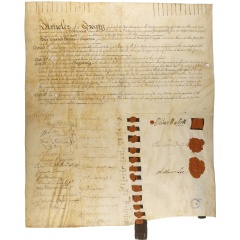1784 Treaty of Fort Stanwix To Go On View at the Smithsonian’s National Museum of the American Indian Beginning Oct. 17

Signed one year after the end of the War of Independence, the 1784 Treaty of Fort Stanwix was one of the first treaties between the newly independent U.S. and a Native nation. It punished four of the Iroquois (Haudenosaunee) Six Nations—the Senecas, Onondagas, Cayugas and Mohawks—for supporting the British during the American Revolution and required them to give up tribal territories in western New York and the Ohio Valley. And although the treaty recognized the land rights of the Oneidas and Tuscaroras, who had allied themselves with the Americans during the war, New York state soon pressured these two nations into ceding their treaty-guaranteed homelands.
On loan from the National Archives, the treaty will be on view in the exhibition “Nation to Nation: Treaties Between the United States and American Indian Nations” though early 2020. Media are invited to an open house with Kevin Gover, director of the National Museum of the American Indian, and representatives of the Iroquois (Haudenosaunee) Six Nations Oct. 17 at
9 a.m.
New York state officials, led by Gov. George Clinton, attempted to negotiate a separate treaty with the Haudenosaunee before the U.S. treaty commissioners arrived at Fort Stanwix, which is located near present-day Rome, New York. The officials hoped to assert New York’s authority over Indian affairs within its borders and pre-empt the federal government, which claimed the sole right to negotiate treaties with Indian nations. Iroquois leaders, however, would not consider any proposals from the state until they had met with the Congressional treaty representatives.
The U.S. sent three treaty commissioners to the Fort Stanwix treaty council—Oliver Wolcott, Richard Butler and Arthur Lee—along with 100 armed militiamen. Also attending the council were approximately 613 Iroquois, including tribal leaders such as Captain Aaron Hill (Mohawk) and Cornplanter (Seneca).
When the treaty council began Oct. 12, 1784, the American treaty commissioners presented the Iroquois with tough terms: To have peace, they would have to recognize that the U.S. had a legitimate claim to sovereignty over Indian lands, return all prisoners of war and agree to land cessions.
The Iroquois were insulted and refused to accept the demands, a posture that angered U.S. treaty officials who considered the Iroquois a “conquered people.” Rejecting all Iroquois counterproposals, the Americans outlined the conditions under which the nations would “be received into the peace and protection of the United States”: the U.S. would retain six Iroquois hostages, to be held until all American prisoners were returned; the Oneidas and Tuscaroras would be secured in the possession of their lands; the Iroquois would cede lands to the U.S.; and trade goods would be distributed to the Iroquois upon signing the treaty.
With limited bargaining power, Iroquois leaders had little alternative but to sign the Fort Stanwix Treaty Oct. 22, 1784, exactly as it was presented to them.
The Iroquois continued to protest the treaty’s legitimacy—opposition that continued until the 1794 Treaty of Canandaigua, which returned to the Seneca territory ceded in the 1784 treaty. Yet Iroquois territory would never be safe. In 1783, Iroquois lands encompassed half of New York state; by the 1840s, New York state had stripped the Iroquois of most of their lands through illegal treaties.
Displaying original treaties in “Nation to Nation” is made possible by the National Archives, an exhibition partner. Several of the treaties received extensive conservation treatment by the National Archives’ conservator prior to loan. There are a total of over 370 ratified Indian treaties in the National Archives. For more information about these treaties, see https://www.archives.gov/research/native-americans/treaties.
The National Museum of the American Indian is committed to advancing knowledge and understanding of the Native cultures of the Western Hemisphere—past, present and future—through partnership with Native people and others. Located on the National Mall at Fourth Street and Independence Avenue S.W., the museum is open every day from 10 a.m. to 5:30 p.m. (closed Dec. 25).
( Press Release Image: https://photos.webwire.com/prmedia/6/248297/248297-1.jpg )
WebWireID248297
This news content was configured by WebWire editorial staff. Linking is permitted.
News Release Distribution and Press Release Distribution Services Provided by WebWire.